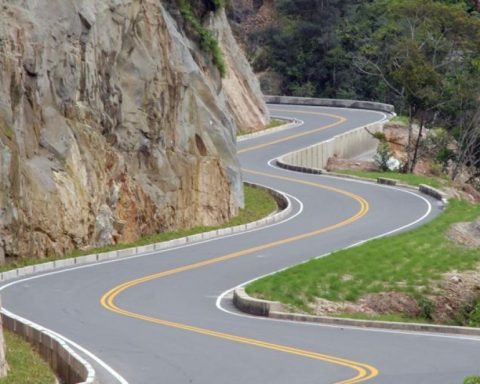The total lunar eclipse that will be recorded between Sunday night and Monday morning will allow the entire surface of the satellite to be seen in a reddish color, hence the popular name “blood moon”, and it will be the last astronomical event of its kind. that can be observed well from the Southern Hemisphere in the remainder of the year.
This eclipse occurs when the Earth stands between the Moon and the Sun and blocks the light that the latter radiates, generating a shadow cone which, depending on the angle at which the bodies meet, can be more or less “dense” and two sectors are generated: the umbra and the penumbra.
Gabriel Brichetto Orquera, a physics graduate and teacher at the Parque Centenario Friends of Astronomy Association, explained in an interview with Télam that “since the Sun is larger than the Earth, it cannot completely block light projections, which is why It’s not that we stop seeing her.”
“The light that reaches the Moon does so with an analogous phenomenon of refraction in the atmosphere that causes a reddish color to be projected,” said the specialist, detailing that “the same thing happens with the Sun during sunrise or sunset and for that reason we see it reddish or orange”.
It is for this phenomenon that the total lunar eclipse is popularly known as “Blood Moon” and the last astronomical event of this type occurred in the past May 26, 2021 was named as “Super moon” because the natural satellite was also closer to Earth.
However, the specialist warned that all these “are terms that serve as triggers for people to start looking at the sky. It is not an astronomical or scientific term, the size of the previous Moon had a minimal difference from this one, no It is something appreciable in the observation”.
In this regard, he stressed that “there are more interest in the population regarding what happens in the skyalthough it is difficult to measure the pandemic involved, it is noticeable that there is more diffusion in the media and people go to specialized places, the fact that technology allows us to follow a streaming eclipse that you can’t see from here also helps a lot”.
eclipse seasons
Next Sunday’s event raises expectations among astronomy fans as it will be the last phenomenon of this type that can be observed well from the Southern Hemisphereand although a partial solar eclipse is expected for October, it can only be seen in much of Europe, northeast Africa and western Asia and on November 8 another will occur, of the Moon visible in Asia, Australia, the Pacific and part from America.
This year we will have four eclipses and this is because “there are seasons of eclipses, which is the time that the Moon crosses the ecliptic -the apparent path of the Sun in the sky- and that happens more or less every six months,” explained Brichetto Orquera.
In addition, he warned that “depending on the phase of the Moon, the type of eclipse that occurs since if it is in a new Moon it will be from the Sun and if it is full it will be from the Moon since it is ‘on the other side of the Sun’ “.
“Since the lunar cycle lasts 28 days, there can be up to three events in each eclipse season, this year we will have four, two in each season,” explained the specialist who, at the age of 14, approached the Parque Centenario observatory and was fascinated by the sky and astronomy, which led him to study Physics at the end of his secondary studies.
Do you want to see a sky show this weekend? ?
May’s Full Moon will pass through Earth’s shadow, turning coppery red for those in the viewing zone. What you need to know about the lunar eclipse of May 15-16: https://t.co/UAhLyzNR9X pic.twitter.com/9JzQunOvES
— NASA in Spanish (@NASA_es) May 13, 2022
The lunar eclipse next Sunday will begin at 1:33 UTC (Universal Time Coordinated), that is, 22:33 Argentine time.
At that moment “the moon enters the penumbra, which is the most ‘diffuse’ part of the shadow, and then, an hour later, it will begin to enter the umbra, which is the most ‘dense’ part of the shadow, and at 00:33 will be in fullness”, said Brichetto Orquera.
“This phase of the eclipse will last about an hour and a half, which is why the event is amazing, compared to that of the sun, in which the most intense part lasts just a few minutes”pointed out the teacher, who summoned those who wish to witness the event to the observatory located at Patricias Argentinas 550, in Parque Centenario, Buenos Aires.
This time, the lunar eclipse will be visible throughout the Argentine territorydepending on the cloudiness in the sky.
According to a map shared by NASA, it can also be fully observed from South America, Central America and the east coast of the United States and partially in Africa and Europe; and will not be visible in the Middle East, India, Asia and Oceania
Activities to observe the eclipse
In Argentina, activities are carried out to observe this phenomenon in different parts of the country.
The total eclipse will have greater visibility in the provinces of La Rioja, Catamarca, Tucumán, Jujuy, Salta, Tierra del Fuego, the west of Santiago del Estero and the east of San Juan, for the rest of the country the National Meteorological Service (SMN) reported that low clouds are forecast.
In the city of Buenos Aires, from 10:30 p.m., friends of astronomy invite you to participate in a meeting to see the Moon through telescopes located in the garden of the place and also from the dome of the historic Gautier telescope that the association has, an activity that will be accompanied by specialists who will guide the fans throughout the meeting and a musical group, with a cost of 400 pesos.
In addition, the Galileo Galilei Planetarium from the Buenos Aires neighborhood of Palermo will carry out an activity to observe the eclipse, from 10 pm on the esplanade of the property where the telescopes will be installed.
These activities are suspended due to rain, but according to the SMN forecast, no precipitation is expected for the Metropolitan Area, although the sky during the afternoon of Sunday night will be “partly cloudy”.
Telescopes will be installed in Bariloche and Las Grutas
Telescopes will be installed in the city of Bariloche and in the Las Grutas spa in the province of Río Negro to make it easier for people to visualize the total lunar eclipse, observatory owners reported.
Telescopes will also be installed in General Roca, while in Las Grutas and El Bolsón, in addition, those interested will be able to see the astrological phenomenon live on Facebook.
Denis Martínez from the “Creek Observatory” of the Las Grutas resort told Télam that “the shadow cone that is generated by the interposition of the Earth between the Sun and the Moon will be transmitted by Facebook” and they will also install “telescopes in the Marina complex Zero for people who want to share the experience.”
Daniel Chieza from the Astropatagonia Observatory in Bariloche stressed that Instagram and Facebook will be the communication channels for people to access the observatory installed in the area known as “Ñirihuau Arriba” that night.
On the other hand, the “Sendero Los Balcones” of the fence of General Roca will be the place chosen from 10:30 p.m. to observe the eclipse.
“It will be a varied dynamic with a walk, talk and observation from a fixed point”, said the organizer member of “Caelum Patagonia”, Amanda Mariquez.
In turn, the natural phenomenon will be broadcast on YouTube, from the El Bolsón Teacher Training Center by the “Osiris Astronomical Group”, “with the coordination for the first time of a group of high school students,” Diego Galperín explained to Télam. .
















